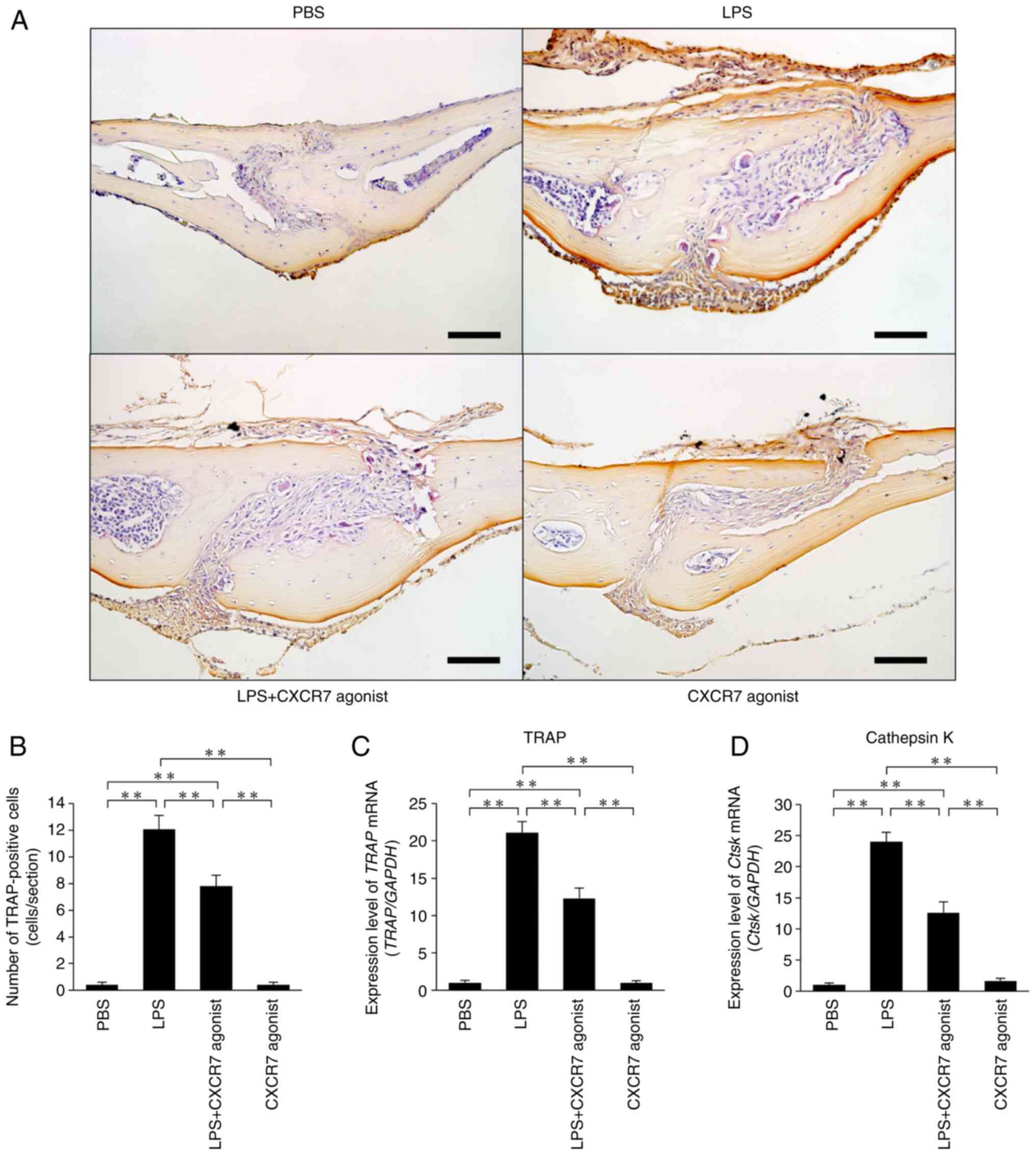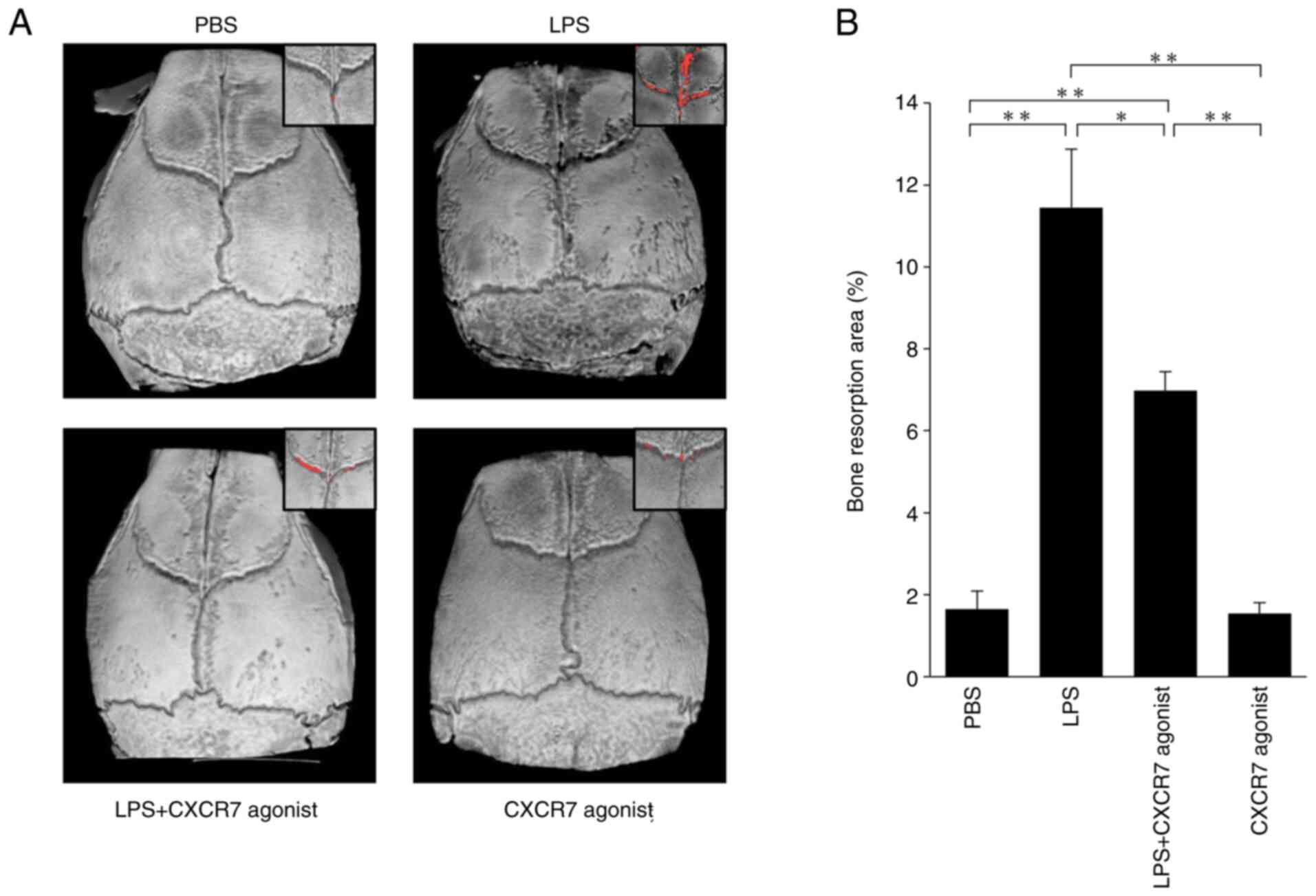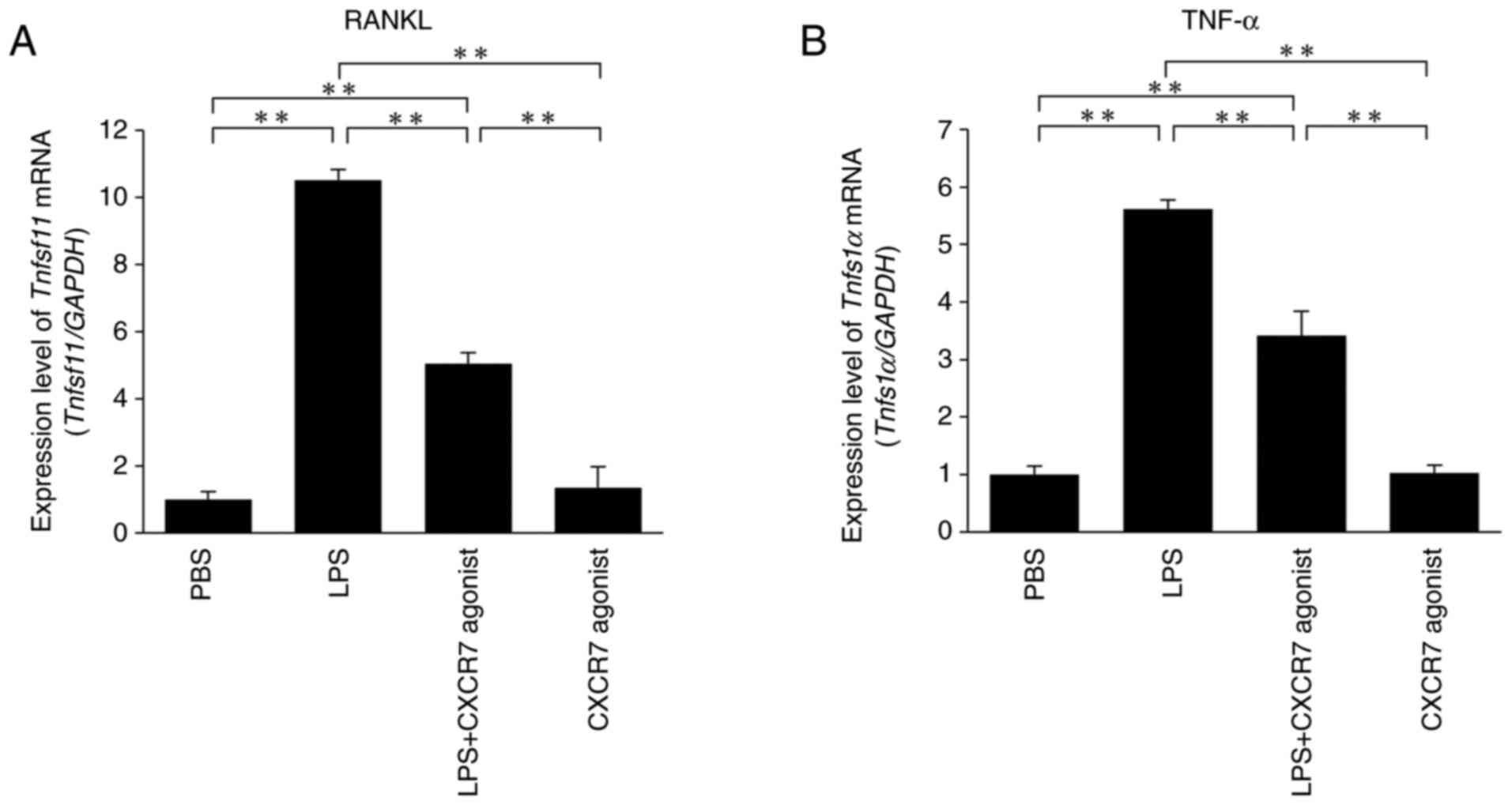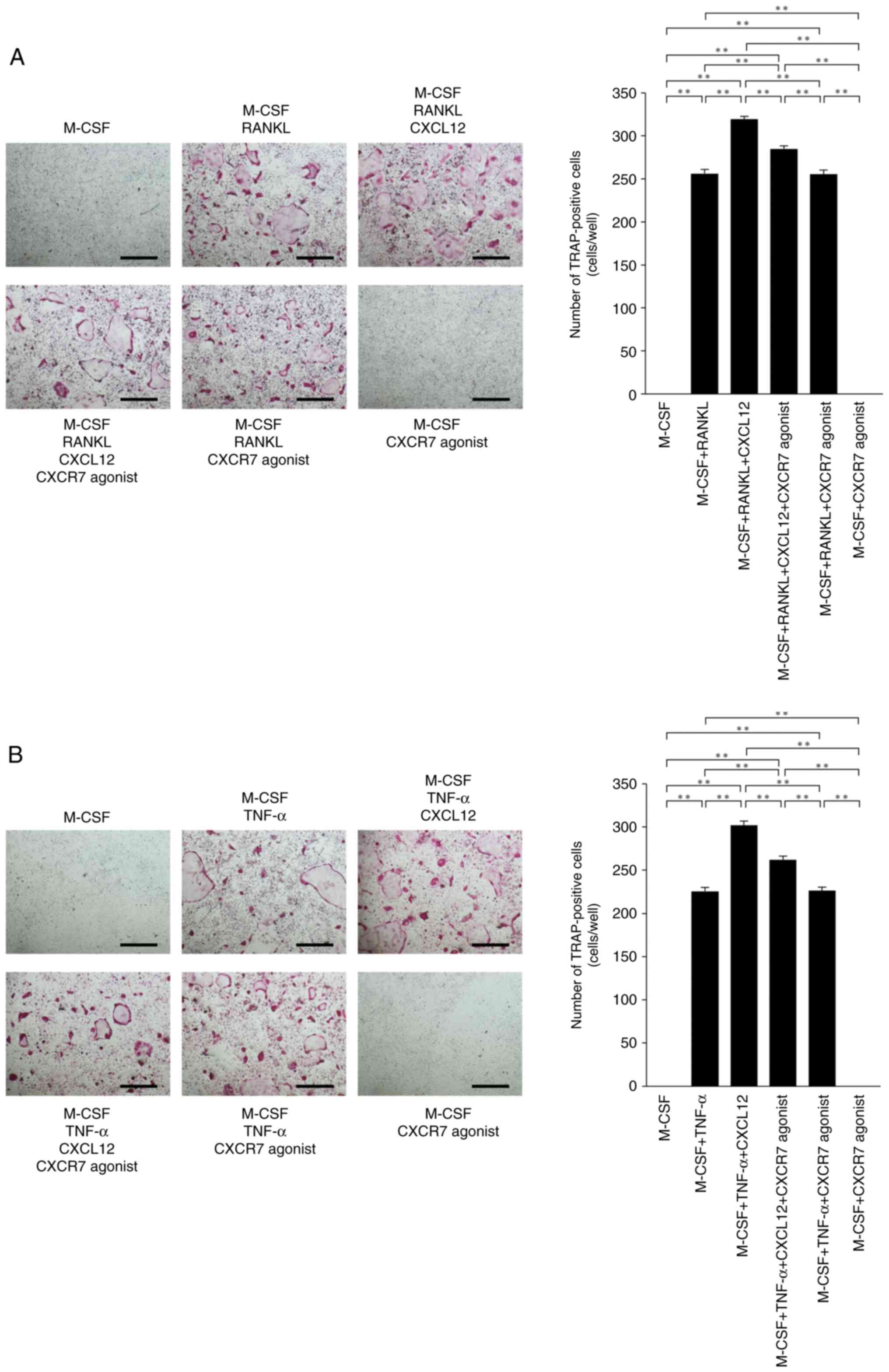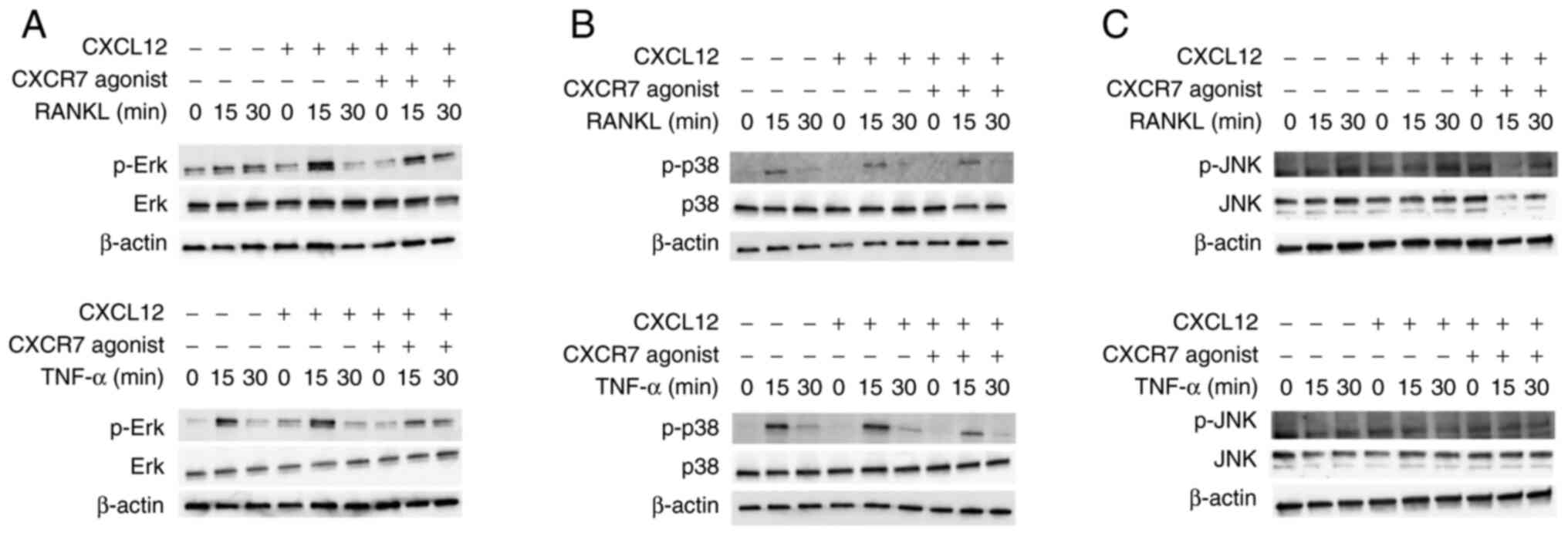|
1
|
Boyce BF, Li J, Xing L and Yao Z: Bone
remodeling and the role of TRAF3 in osteoclastic bone resorption.
Front Immunol. 9:22632018. View Article : Google Scholar : PubMed/NCBI
|
|
2
|
Crotti TN, Dharmapatni AA, Alias E and
Haynes DR: Osteoimmunology: Major and costimulatory pathway
expression associated with chronic inflammatory induced bone loss.
J Immunol Res. 2015:2812872015. View Article : Google Scholar : PubMed/NCBI
|
|
3
|
Teitelbaum SL: Bone resorption by
osteoclasts. Science. 289:1504–1508. 2000. View Article : Google Scholar : PubMed/NCBI
|
|
4
|
Azuma Y, Kaji K, Katogi R, Takeshita S and
Kudo A: Tumor necrosis factor-alpha induces differentiation of and
bone resorption by osteoclasts. J Biol Chem. 275:4858–4864. 2000.
View Article : Google Scholar : PubMed/NCBI
|
|
5
|
Kobayashi K, Takahashi N, Jimi E, Udagawa
N, Takami M, Kotake S, Nakagawa N, Kinosaki M, Yamaguchi K, Shima
N, et al: Tumor necrosis factor alpha stimulates osteoclast
differentiation by a mechanism independent of the ODF/RANKL-RANK
interaction. J Exp Med. 191:275–286. 2000. View Article : Google Scholar : PubMed/NCBI
|
|
6
|
Kitaura H, Zhou P, Kim HJ, Novack DV, Ross
FP and Teitelbaum SL: M-CSF mediates TNF-induced inflammatory
osteolysis. J Clin Invest. 115:3418–3427. 2005. View Article : Google Scholar : PubMed/NCBI
|
|
7
|
Xing Q, de Vos P, Faas MM, Ye Q and Ren Y:
LPS promotes pre-osteoclast activity by up-regulating CXCR4 via
TLR-4. J Dent Res. 90:157–162. 2011. View Article : Google Scholar : PubMed/NCBI
|
|
8
|
Islam S, Hassan F, Tumurkhuu G, Dagvadorj
J, Koide N, Naiki Y, Mori I, Yoshida T and Yokochi T: Bacterial
lipopolysaccharide induces osteoclast formation in RAW 264.7
macrophage cells. Biochem Biophys Res Commun. 360:346–351. 2007.
View Article : Google Scholar : PubMed/NCBI
|
|
9
|
Mörmann M, Thederan M, Nackchbandi I,
Giese T, Wagner C and Hänsch GM: Lipopolysaccharides (LPS) induce
the differentiation of human monocytes to osteoclasts in a tumour
necrosis factor (TNF) alpha-dependent manner: A link between
infection and pathological bone resorption. Mol Immunol.
45:3330–3337. 2008. View Article : Google Scholar : PubMed/NCBI
|
|
10
|
Zou W and Bar-Shavit Z: Dual modulation of
osteoclast differentiation by lipopolysaccharide. J Bone Miner Res.
17:1211–1218. 2002. View Article : Google Scholar : PubMed/NCBI
|
|
11
|
Kimura K, Kitaura H, Fujii T, Hakami ZW
and Takano-Yamamoto T: Anti-c-Fms antibody inhibits
lipopolysaccharide-induced osteoclastogenesis in vivo. FEMS Immunol
Med Microbiol. 64:219–227. 2012. View Article : Google Scholar : PubMed/NCBI
|
|
12
|
Kikuchi T, Matsuguchi T, Tsuboi N, Mitani
A, Tanaka S, Matsuoka M, Yamamoto G, Hishikawa T, Noguchi T and
Yoshikai Y: Gene expression of osteoclast differentiation factor is
induced by lipopolysaccharide in mouse osteoblasts via Toll-like
receptors. J Immunol. 166:3574–3579. 2001. View Article : Google Scholar : PubMed/NCBI
|
|
13
|
Lee J, Park C, Kim HJ, Lee YD, Lee ZH,
Song YW and Kim HH: Stimulation of osteoclast migration and bone
resorption by C-C chemokine ligands 19 and 21. Exp Mol Med.
49:e3582017. View Article : Google Scholar : PubMed/NCBI
|
|
14
|
Votta BJ, White JR, Dodds RA, James IE,
Connor JR, Lee-Rykaczewski E, Eichman CF, Kumar S, Lark MW and
Gowen M: CKbeta-8 [CCL23], a novel CC chemokine, is chemotactic for
human osteoclast precursors and is expressed in bone tissues. J
Cell Physiol. 183:196–207. 2000. View Article : Google Scholar : PubMed/NCBI
|
|
15
|
Watanabe K, Penfold ME, Matsuda A,
Ohyanagi N, Kaneko K, Miyabe Y, Matsumoto K, Schall TJ, Miyasaka N
and Nanki T: Pathogenic role of CXCR7 in rheumatoid arthritis.
Arthritis Rheum. 62:3211–3220. 2010. View Article : Google Scholar : PubMed/NCBI
|
|
16
|
Puchert M and Engele J: The peculiarities
of the SDF-1/CXCL12 system: In some cells, CXCR4 and CXCR7 sing
solos, in others, they sing duets. Cell Tissue Res. 355:239–253.
2014. View Article : Google Scholar : PubMed/NCBI
|
|
17
|
Chen D, Xia Y, Zuo K, Wang Y, Zhang S,
Kuang D, Duan Y, Zhao X and Wang G: Crosstalk between SDF-1/CXCR4
and SDF-1/CXCR7 in cardiac stem cell migration. Sci Rep.
5:168132015. View Article : Google Scholar : PubMed/NCBI
|
|
18
|
Okada K, Kawao N, Yano M, Tamura Y,
Kurashimo S, Okumoto K, Kojima K and Kaji H: Stromal cell-derived
factor-1 mediates changes of bone marrow stem cells during the bone
repair process. Am J Physiol Endocrinol Metab. 310:E15–E23. 2016.
View Article : Google Scholar : PubMed/NCBI
|
|
19
|
Teixido J, Martinez-Moreno M,
Diaz-Martinez M and Sevilla-Movilla S: The good and bad faces of
the CXCR4 chemokine receptor. Int J Biochem Cell Biol. 95:121–131.
2018. View Article : Google Scholar : PubMed/NCBI
|
|
20
|
Dong Y, Liu H, Zhang X, Xu F, Qin L, Cheng
P, Huang H, Guo F, Yang Q and Chen A: Inhibition of SDF-1α/CXCR4
signalling in subchondral bone attenuates post-traumatic
osteoarthritis. Int J Mol Sci. 17:9432016. View Article : Google Scholar : PubMed/NCBI
|
|
21
|
Pawig L, Klasen C, Weber C, Bernhagen J
and Noels H: Diversity and inter-connections in the CXCR4 chemokine
receptor/ligand family: Molecular perspectives. Front Immunol.
6:4292015. View Article : Google Scholar : PubMed/NCBI
|
|
22
|
Shima K, Kimura K, Ishida M, Kishikawa A,
Ogawa S, Qi J, Shen WR, Ohori F, Noguchi T, Marahleh A and Kitaura
H: C-X-C Motif Chemokine 12 enhances lipopolysaccharide-induced
osteoclastogenesis and bone resorption in vivo. Calcif Tissue Int.
103:431–442. 2018. View Article : Google Scholar : PubMed/NCBI
|
|
23
|
Luo T, Liu H, Feng W, Liu D, Du J, Sun J,
Wang W, Han X, Guo J, Amizuka N, et al: Adipocytes enhance
expression of osteoclast adhesion-related molecules through the
CXCL12/CXCR4 signalling pathway. Cell Prolif. 50:e123172017.
View Article : Google Scholar : PubMed/NCBI
|
|
24
|
Hatano K, Ishida Y, Yamaguchi H, Hosomichi
J, Suzuki JI, Usumi-Fujita R, Shimizu Y, Shibutani N, Kaneko S and
Ono T: The chemokine receptor type 4 antagonist, AMD3100,
interrupts experimental tooth movement in rats. Arch Oral Biol.
86:35–39. 2018. View Article : Google Scholar : PubMed/NCBI
|
|
25
|
Uto-Konomi A, McKibben B, Wirtz J, Sato Y,
Takano A, Nanki T and Suzuki S: CXCR7 agonists inhibit the function
of CXCL12 by down-regulation of CXCR4. Biochem Biophys Res Commun.
431:772–776. 2013. View Article : Google Scholar : PubMed/NCBI
|
|
26
|
McHugh KP, Hodivala-Dilke K, Zheng MH,
Namba N, Lam J, Novack D, Feng X, Ross FP, Hynes RO and Teitelbaum
SL: Mice lacking beta3 integrins are osteosclerotic because of
dysfunctional osteoclasts. J Clin Invest. 105:433–440. 2000.
View Article : Google Scholar : PubMed/NCBI
|
|
27
|
Kitaura H, Sands MS, Aya K, Zhou P,
Hirayama T, Uthgenannt B, Wei S, Takeshita S, Novack DV, Silva MJ,
et al: Marrow stromal cells and osteoclast precursors
differentially contribute to TNF-alpha-induced osteoclastogenesis
in vivo. J Immunol. 173:4838–4846. 2004. View Article : Google Scholar : PubMed/NCBI
|
|
28
|
Takeshita S, Kaji K and Kudo A:
Identification and characterization of the new osteoclast
progenitor with macrophage phenotypes being able to differentiate
into mature osteoclasts. J Bone Miner Res. 15:1477–1488. 2000.
View Article : Google Scholar : PubMed/NCBI
|
|
29
|
Saeed J, Kitaura H, Kimura K, Ishida M,
Sugisawa H, Ochi Y, Kishikawa A and Takano-Yamamoto T: IL-37
inhibits lipopolysaccharide-induced osteoclast formation and bone
resorption in vivo. Immunol Lett. 175:8–15. 2016. View Article : Google Scholar : PubMed/NCBI
|
|
30
|
Ishida M, Kitaura H, Kimura K, Sugisawa H,
Aonuma T, Takada H and Takano-Yamamoto T: Muramyl dipeptide
enhances lipopolysaccharide-induced osteoclast formation and bone
resorption through increased RANKL expression in stromal cells. J
Immunol Res. 2015:1327652015. View Article : Google Scholar : PubMed/NCBI
|
|
31
|
Livak KJ and Schmittgen TD: Analysis of
relative gene expression data using real-time quantitative PCR and
the 2(−Delta Delta C(T)) method. Methods. 25:402–408. 2001.
View Article : Google Scholar : PubMed/NCBI
|
|
32
|
Ohori F, Kitaura H, Ogawa S, Shen WR, Qi
J, Noguchi T, Marahleh A, Nara Y, Pramusita A and Mizoguchi I:
IL-33 inhibits TNF-α-induced osteoclastogenesis and bone
resorption. Int J Mol Sci. 21:11302020. View Article : Google Scholar : PubMed/NCBI
|
|
33
|
Wijtmans M, Maussang D, Sirci F, Scholten
DJ, Canals M, Mujić-Delić A, Chong M, Chatalic KL, Custers H,
Janssen E, et al: Synthesis, modeling and functional activity of
substituted styrene-amides as small-molecule CXCR7 agonists. Eur J
Med Chem. 51:184–192. 2012. View Article : Google Scholar : PubMed/NCBI
|
|
34
|
Nagashima H, Shinoda M, Honda K, Kamio N,
Hasuike A, Sugano N, Arai Y, Sato S and Iwata K: CXCR4 signaling
contributes to alveolar bone resorption in Porphyromonas
gingivalis-induced periodontitis in mice. J Oral Sci.
59:571–577. 2017. View Article : Google Scholar : PubMed/NCBI
|
|
35
|
Pablos JL, Santiago B, Galindo M, Torres
C, Brehmer MT, Blanco FJ and García-Lázaro FJ: Synoviocyte-derived
CXCL12 is displayed on endothelium and induces angiogenesis in
rheumatoid arthritis. J Immunol. 170:2147–2152. 2003. View Article : Google Scholar : PubMed/NCBI
|
|
36
|
Yang L, Wang M, Guo YY, Sun T, Li YJ, Yang
Q, Zhang K, Liu SB, Zhao MG and Wu YM: Systemic inflammation
induces anxiety disorder through CXCL12/CXCR4 pathway. Brain Behav
Immun. 56:352–362. 2016. View Article : Google Scholar : PubMed/NCBI
|
|
37
|
Kitaura H, Ishida M, Kimura K, Sugisawa H,
Kishikawa A, Shima K, Ogawa S, Qi J and Shen WR: Role of muramyl
dipeptide in lipopolysaccharide-mediated biological activity and
osteoclast activity. Anal Cell Pathol (Amst).
2018:80476102018.PubMed/NCBI
|
|
38
|
Lee SY, Moon JS, Yang DW, Yoo HI, Jung JY,
Kim OS, Kim MS, Koh JT, Chung HJ and Kim SH: SLPI in periodontal
Ligament is not sleepy during biophysical force-induced tooth
movement. J Clin Periodontol. 48:528–540. 2021. View Article : Google Scholar : PubMed/NCBI
|
|
39
|
Ishida M, Shen WR, Kimura K, Shima K,
Ogawa S, Qi J, Ohori F, Noguchi T, Marahleh A and Kitaura H: DPP-4
inhibitor impedes lipopolysaccharide-induced osteoclast formation
and bone resorption in vivo. Biomed Pharmacother. 109:242–253.
2019. View Article : Google Scholar : PubMed/NCBI
|
|
40
|
Rajagopal S, Kim J, Ahn S, Craig S, Lam
CM, Gerard NP, Gerard C and Lefkowitz RJ: Beta-arrestin-but not G
protein-mediated signaling by the ‘decoy’ receptor CXCR7. Proc Natl
Acad Sci USA. 107:628–632. 2010. View Article : Google Scholar : PubMed/NCBI
|
|
41
|
Hattermann K, Held-Feindt J, Lucius R,
Müerköster SS, Penfold ME, Schall TJ and Mentlein R: The chemokine
receptor CXCR7 is highly expressed in human glioma cells and
mediates antiapoptotic effects. Cancer Res. 70:3299–3308. 2010.
View Article : Google Scholar : PubMed/NCBI
|
|
42
|
Lounsbury N: Advances in CXCR7 modulators.
Pharmaceuticals (Basel). 13:332020. View Article : Google Scholar : PubMed/NCBI
|















